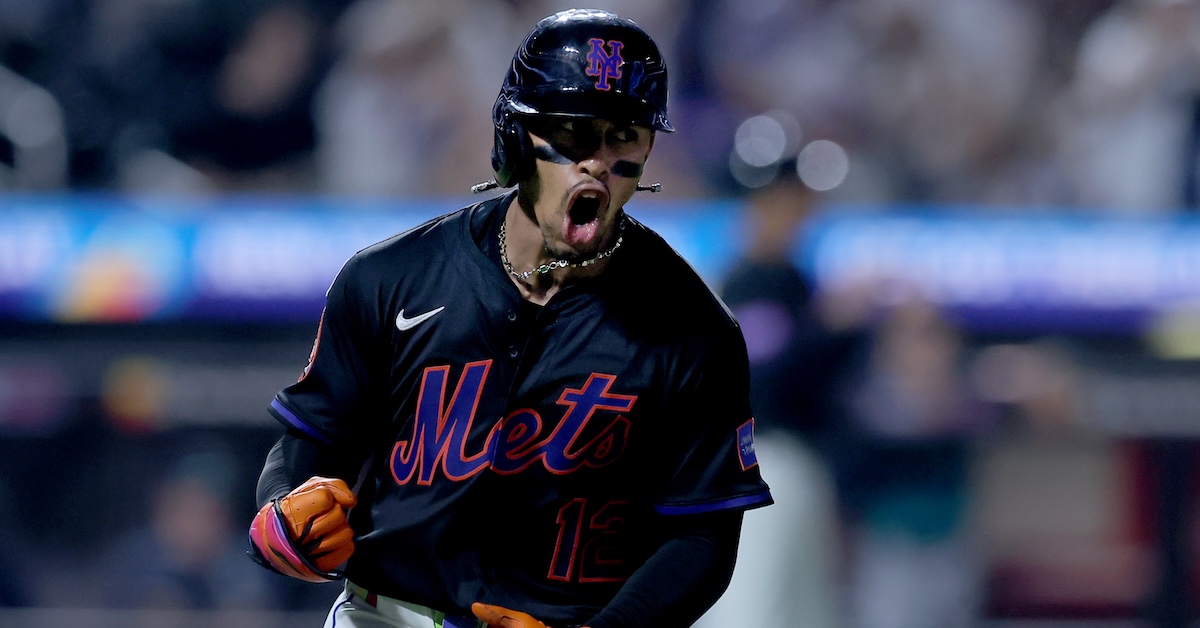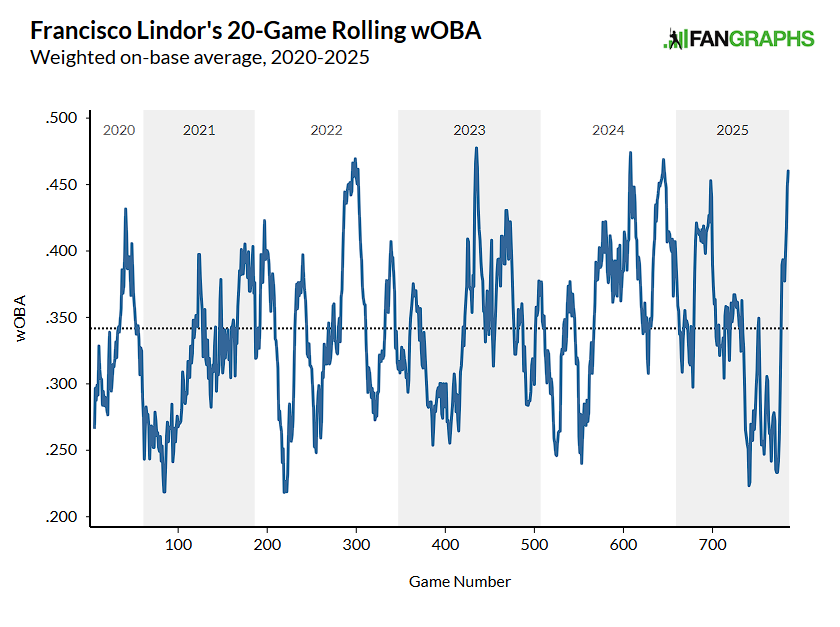Francisco Lindor Is Back, and Also Never Left

The Mets are the best Rorschach test in baseball right now. You can see almost anything you want to when you look at them. A band of high-paid underachievers? Sure. A great team in a rough stretch? Yup. A triumph of pitching development? Sure thing, but also a cautionary tale about what happens when you don’t have enough starters to get through the season. Each of those topics – and plenty more – are worth a closer look. But in watching the Mets in recent weeks, I’ve been struck by the same observation every time I watch a game. That observation? Man, Francisco Lindor is good.
Lindor has been right at the center of the Mets’ mid-summer meltdown. After starting the season as hot as he ever has, he posted two straight abysmal months in June and July while the team swooned in sympathy. I’m not sure you understand quite how bad it was, so let’s look at the numbers. He hit a desultory .205/.258/.371 over those two months, good for a 77 wRC+. So imagine my surprise when I looked at this year’s hitting leaderboard and saw Lindor’s 4.7 WAR in 11th place.
Now, am I writing an article to tell you that Francisco Lindor is good? I mean, kind of. More than that, though, I’m thinking of this as an appreciation post. Lindor’s year-to-year consistency is otherworldly. He’s putting the finishing touches on his fourth straight five-win campaign, all with wRC+ marks between 121 and 137. He’s doing it without it ever feeling like it’s unsustainable. So let’s appreciate that greatness and take a look at what this year’s roller coaster says about Lindor’s time in Queens more broadly.
The first thing I wondered was whether Lindor’s cold-to-hot transition is unprecedented, but of course it isn’t. It’s not even unprecedented for Lindor, in fact. Lindor has had similarly cold 20-game stretches and similarly hot 20-game stretches in each of the past three years. Here’s his entire Mets career broken up into rolling 20-game observations of wOBA:

Many slumps and hot streaks are inexplicable. The reason for Lindor’s 2025 rough patch, on the other hand, is easy to pinpoint. On June 4, Lindor broke his pinky toe. Up to that point, he was hitting the ball with authority. Then, for around two months, a reasonable recovery window for such an injury, he turned into a slap hitter with below-average results on contact. Finally, and with a customary warning about arbitrary endpoints, he’s sure looked healthy since then:
| Split | wOBACON | Hard Hit% | Barrel% | EV |
|---|---|---|---|---|
| Pre-6/4 | .399 | 45.2% | 9.6% | 90.6 |
| 6/4-8/4 | .323 | 40.5% | 6.3% | 88.5 |
| Since | .487 | 54.5% | 10.9% | 94.9 |
I’m completely willing to buy that story of Lindor’s struggles. Generally speaking, a lot of a hitter’s power comes from the lower body, and it’s very easy to imagine that a broken toe would prevent Lindor from getting his best swing off as frequently. His swing speed didn’t change during this time, but that’s not the question here; it’s more about maintaining balance, particularly since the pinky toe is most important for its stabilizing effect. If you’re off balance when you swing because your own feet aren’t working right, hitting gets much harder, naturally enough.
Shockingly, Lindor barely missed a game while he dealt with his toe. The Mets played 52 games in the two months after he broke his pinky. Lindor missed the first one after the injury, pinch-hit in the second, and then started the next 50 in a row. He’s started every game since then, in fact; I just liked the round 50-game cutoff to really emphasize his consistency. The point is that Lindor was clearly compromised but playing through it, which affected his results meaningfully.
Lindor’s results on contact have long been the key to his offensive excellence. Ever wonder how a 5-foot-10 shortstop hits 30 homers a year? It’s because he gets the ball in the air a ton and manages average results on those batted balls. He’s never been a standout when it comes to turning fly balls into homers, but that doesn’t matter as long as you rarely strike out, take walks, and put plenty of balls in the air. He’s consistently close to the top of the majors in homers per plate appearance (and thus home runs generally thanks to his durability) despite never displaying elite power on contact:
| Year | Air wOBA | HR/PA | Air wOBA Pctile | HR/PA Pctile |
|---|---|---|---|---|
| 2022 | .480 | 3.7% | 51 | 68 |
| 2023 | .474 | 4.5% | 37 | 78 |
| 2024 | .509 | 4.8% | 65 | 84 |
| 2025 | .491 | 4.3% | 65 | 73 |
This is one of those balancing acts that works not because Lindor is capable of generating massive thump, but because he’s preternaturally skillful. He has average plate discipline overall – his chase rate and swing rate both fluctuate around league average. He makes plenty of contact, though, which keeps his strikeout rate down, and he elevates a ton of that contact. That makes his power play up; despite never displaying standout bat speed or peak exit velocities, he gets a ton of bites at the home run apple because of all the fly balls he’s able to hit, and hit to the pull side from both sides of the plate to boot.
If that balance sounds hard to strike, that’s because it is. Generating slugger-tier power from average raw power is incredibly hard! Maybe that’s what Ron Washington should have been talking about in Moneyball. What’s more, Lindor’s game is balanced on a fine edge. When he’s generating enough force to get the ball out of the yard, it’s great. Bring him down to below-average power, though, and all of the sudden the home runs turn into fly outs and the equation breaks.
Think of it this way: July was the worst month of Lindor’s Mets career in terms of his hard-hit rate on elevated contact. It was the lowest by a lot, and that’s including his down 2021 season. If you’re looking for an explanation of why he went from excellent to abysmal, “all of his best contact turned into fly outs” is about as clean of an explanation as you can get.
Now, will Lindor keep hitting like he has in August? Almost certainly not. This month, his hard-hit rate on elevated contact is the second-highest of his Mets career. It’s in a tiny sample, as this statistic will always be; a month of elevated contact is usually something like 50 batted balls. But he doesn’t need to keep hitting this well to be valuable. So long as he’s delivering average results on elevated contact, his ability to tap into that skill frequently without strikeout problems provides him with a very high floor.
In fact, I think that his months-long slump does a great job of showing how impressive Lindor’s career has been. His game balances on a fine edge. Make any aspect of his offense 10% worse, and that balance wouldn’t really work. An alternate version of Lindor who struck out 25% of the time wouldn’t make up for it with batted ball quality. A version who hit too many grounders would have a far lower offensive ceiling; it’s hard to crank 30 homers with this kind of bat speed if you aren’t putting a lot of balls in the air. We just saw what happens when his contact quality goes down; the extra-base hits stop flowing, and a river of fly balls that don’t leave the ballpark is a great way to depress your BABIP and OBP.
Even worse, pitchers aren’t static opponents. When Lindor’s power started to dip, he faced more pitches in the zone. He went from seeing strikes at an average rate to a 93rd-percentile rate. His walk rate plummeted as a result, further sapping his overall results. Add in a dash of bad luck and a pinch of lowered speed (he broke his toe!), and you have all the ingredients for a miserable month or two.
That’s what happens when Lindor isn’t right. Maybe the slumps aren’t always so deep, and maybe the recoveries aren’t always so strong, but the general idea holds. Lindor is walking a narrow tightrope to keep putting up offensive numbers 25% better than league average. You could make an argument that his base rate is a little bit better than that, in fact. He suffered a lower back injury at the tail end of the 2024 season, played through a bone spur in his right elbow in 2023, and broke his finger by accidentally slamming a hotel door shut on it in 2022. Each of those injuries came with shockingly abbreviated time away from the team plus a slump upon returning.
In other words, he’s dealt with injury issues in each of the last four years. During that time, he’s third in the major leagues in plate appearances. No shortstop has played more defensive innings. Lindor hasn’t taken much time off to recover even as he’s dealt with an array of nagging injuries. He’s played through them, with accompanying dips in performance, and come out the other side healthy.
In 2025, it looks like Lindor has done it again. He’s on course for another excellent season. The Mets have pulled out of their summer swoon for now, and are up to a 91.1% chance of reaching the playoffs after dipping into the mid-70s at the depths of their slump. And when we look back on Lindor’s 2025 a few years down the road, all we’ll see is that he played every day and was 25% better than average offensively and a great defender. The steep injury-related slump and swift recovery? The dedication to play 50 straight games with a broken toe? They will have vanished, obscured by Lindor’s phenomenal consistency.
All statistics current through games of Sunday, August 24.
Ben is a writer at FanGraphs. He can be found on Bluesky @benclemens.

Don’t have much to add but this is fantastic article on a great player if only he never breaks his toe he might have been a mvp finalist again. You know as a Met fan I feel incredibly lucky to see him play